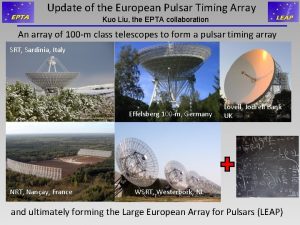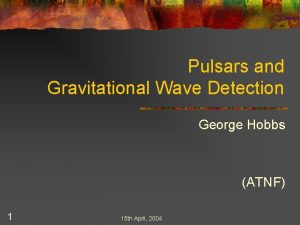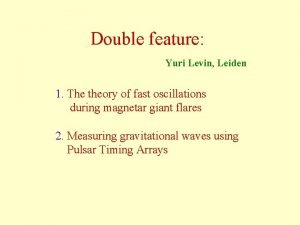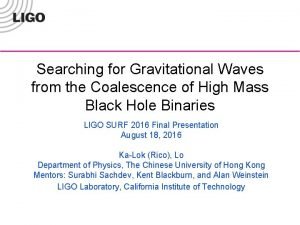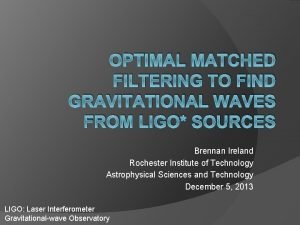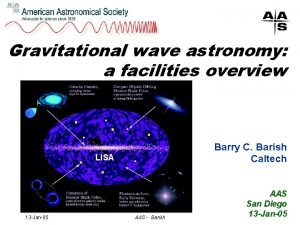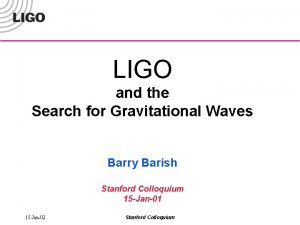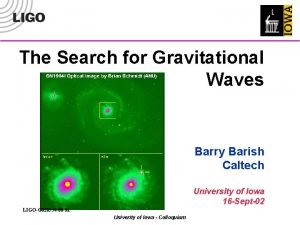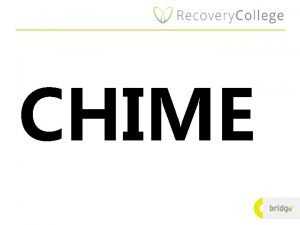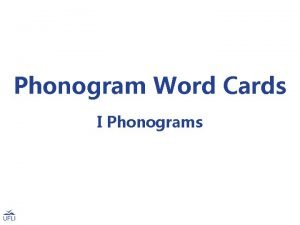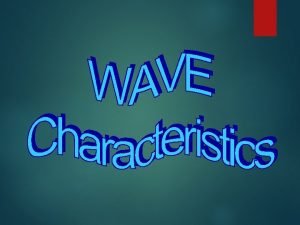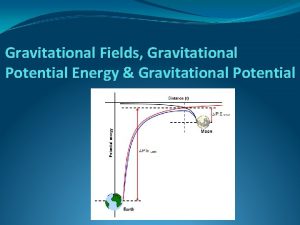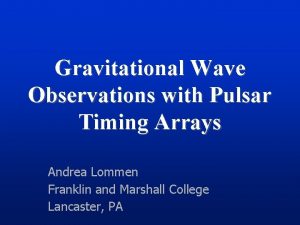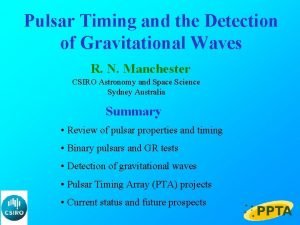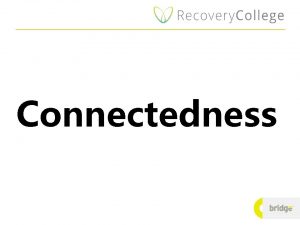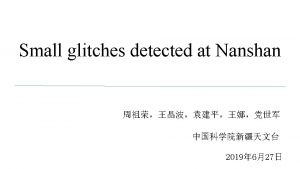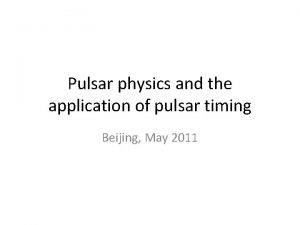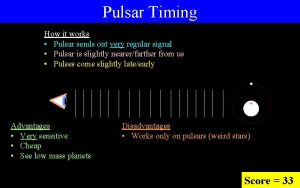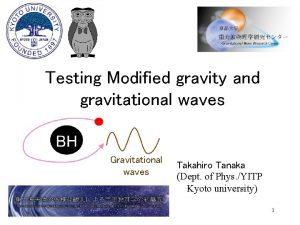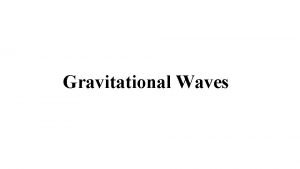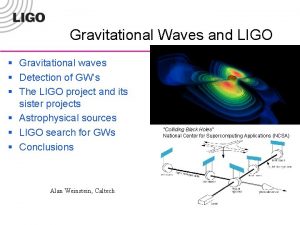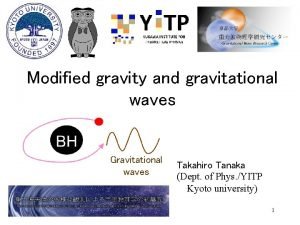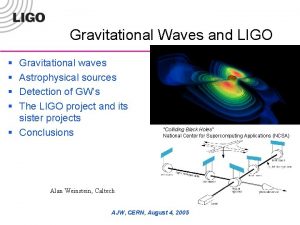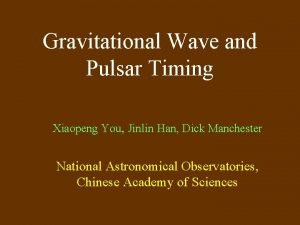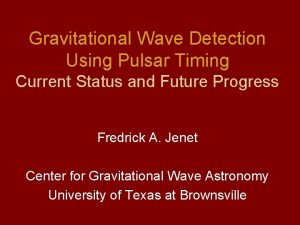Pulsar Timing Arrays CHIME in on Gravitational Waves



























- Slides: 27

Pulsar Timing Arrays CHIME in on Gravitational Waves Deborah Good (CHIME/Pulsar collaboration, NANOGrav) June 24, 2019

Using Pulsars to detect gravitational waves

Image Credit: NASA

What (and who) is NANOGrav? ● NANOGrav is a collaboration of over 100 researchers from 40 institutions across North America. ● Our goal is to detect low-frequency gravitational waves resulting from the stochastic gravitational wave background or individual SMBH mergers (continuous wave signals), using precision pulsar timing measurements from an array of (currently) 56 pulsars.

Quick reminder: Pulsars ● Pulsars: ○ ○ Rapidly rotating neutron stars Large magnetic fields ● Pulsars & Gravity ○ ○ Double pulsar system provided indirect proof of gravitational radiation Pulsar binaries provide important tests of gravity. ● Millisecond pulsars: ○ ○ “Recycled” Extremely accurate clocks. Image credit: NRAO

How do we see gravitational waves with pulsars? A gravitational wave signal in pulsar-timing array data will create a correlated signature in the timing residuals for all pairs of pulsars, dependent only on the pulsar pair baseline. Image credit: NANOGrav Collaboration

How do we time pulsars? ● Observe pulsars (we use mostly Arecibo Observatory & the Green Bank Telescope) regularly for a long period of time (14+ years for NANOGrav) ● Determine Times of Arrival (TOAs) for every observation ● Fit a timing solution to the total set of data. ● Focus in on residuals and model out as much structure as possible. Lorimer & Kramer 2004

Slide from Jeff Hazboun (and David Nice) What do we see when we time pulsars? Rotation Period Derivative Keplerian Orbital Elements Relativistic Orbital Elements Kinematic Perturbations of Orbital Elements Dispersion Measure Variation Position Proper Motion Parallax Solar Electron Density

What do we see when we time pulsars? (Arzoumanian et. al. 2018)

NANOGrav Current Status 11 yr Spatial Correlations Image credit: NANOGrav Collaboration (Arzoumanian et. al. 2018)

NANOGrav Current Status: Upper Limit on Stochastic Gravitational Wave Background ● ● (Arzoumanian et. al. 2018) Green, orange, and blue lines: predictions for the stochastic gravitational wave background. Black line: GWB-amplitude 95% upper limits for an uncorrelated common process ○ Solid: with γ = 13/3 power law ○ Dashed: with independently determined components.

NANOGrav Current Status: Upper Limit on Continuous Wave Signals (Aggarwal et. al. 2019)

Using CHIME for pulsar timing

Imagine you were designing a new instrument to improve the NANOGrav data set. What data would you like to get from that instrument? What isn’t well-covered by current NANOGrav data? What other science could you explore at the same time?

Imagine you were designing a new instrument to improve the NANOGrav data set. You would probably want… ● High cadence data with lots of TOAs ● At a frequency range where pulsar emission is bright ● But where you can learn new things you didn’t know from other NANOGrav observations to improve that data ● While still being able to integrate new TOA measurements into the NANOGrav dataset. ● (And you might want to be able to do other science too!)

The Canadian Hydrogen Intensity Mapping Experiment (CHIME) Originally designed to map redshifted neutral hydrogen to detect baryon acoustic oscillations and constrain dark energy, it now hosts several projects, including a pulsar timing project and a fast radio burst search. CHIME is a radio transit telescope, with no moving parts, which observes 24/7.

What is CHIME? Video Credit: Richard Shaw/CHIME Collaboration Parameter CHIME/FRB Value Collecting Area 8000 m 2 Number of cylinders 4 Number of antennae 1024, each with 2 polarizations Frequency Range 400 -800 MHz E-W Fo. V 2. 5 -1. 3° N-S Fo. V ~110°

How does CHIME meet NANOGrav’s needs? CHIME/Pulsar can: ● Observe (and time) every northern hemisphere NANOGrav pulsar every day ● Monitor for Dispersion Measure & scattering variations Combined, this will result in up to factor of 2 timing improvement!

CHIME/Pulsar can observe NANOGrav pulsars daily Image: Ng & CHIME/Pulsar Collaboration 2017

CHIME/Pulsar System Details Image: Ng & CHIME/Pulsar Collaboration 2017

CHIME/Pulsar System Details ● In the X-Engine: ○ ● Form 10 tracking beams In 10 pulsar GPU nodes: ○ ○ ○ Data are scaled down, encoded into 4+4 complex numbers, and packetized in VDIF format. Fold Mode: Data are coherently dedispersed with DSPSR Filter-bank Mode: Data are processed using CHIME specific software capable of handling DM up to 2500 pc/cm 3. Parameter CHIME Value Number of Tracking Beams 10 Frequency Resolution 390 k. Hz Spectral channels 1024 Output data bit depth 8 or 16 bits Output polarization info Full Stokes (fold mode) Total intensity (filter bank) Pulsar data output rate 67 Mbps ● Scheduler & Monitoring ○ ○ Automatic scheduler ensures pulsars are observed 24/7, prioritizing PTA pulsars. Web monitoring tools to check on performance.

CHIME/Pulsar System Performance While we still have work to do, our observed signal to noise is increasingly lining up with our expected signal to noise. Preliminary Red points: Millisecond pulsars Blue Points: Pulsars with declination <0 deg Black Points: All other pulsars Image credit: Cherry Ng

CHIME/Pulsar System Performance Preliminary Image credit: Cherry Ng

Recent results: Successful measurements of NANOGrav pulsars Max Planck Institute for Radio Astronomy Preliminary Image credit: Emmanuel Fonseca

Left: NANOGrav 11 year release (Arzoumanian et. al. 2018). Right: CHIME/Pulsar preliminary timing Image credit: Emmanuel Fonseca Recent Results from CHIME: Early timing residuals Preliminary

Science with CHIME/Pulsar: beyond NANOGrav ● Discovering new (slow, not milli-second) pulsars ● Discovering new Rotating Radio Transients (RRATs) ● Monitoring known RRATs and pulsars with interesting time domain structure ● Mode Changing ● Nulling ● Monitoring ISM Weather ● Repeating FRB follow-up

Conclusions ● Searching for gravitational waves with pulsar timing provides a handle on a different portion of the gravitational wave spectrum than that studied by LIGO (or LISA). ● NANOGrav continues to set upper limits on the stochastic gravitational wave background, which are beginning to rule out models. 12. 5 year dataset coming soon! ● CHIME/Pulsar is an exciting new instrument which will help improve our NANOGrav dataset by as much as a factor of 2.
 Pulsar timing
Pulsar timing Pulsar timing
Pulsar timing Pulsar timing
Pulsar timing Gravitational waves
Gravitational waves Matched filtering gravitational waves
Matched filtering gravitational waves Gravitational waves
Gravitational waves Gravitational waves
Gravitational waves Barry univerity
Barry univerity Seismic waves
Seismic waves Example of mechanical wave
Example of mechanical wave Constructive waves and destructive waves difference
Constructive waves and destructive waves difference Mechanical waves and electromagnetic waves similarities
Mechanical waves and electromagnetic waves similarities Short wave vs long wave radiation
Short wave vs long wave radiation Is a seismic wave mechanical or electromagnetic
Is a seismic wave mechanical or electromagnetic Mechanical waves and electromagnetic waves
Mechanical waves and electromagnetic waves Examples of mechanical and electromagnetic waves
Examples of mechanical and electromagnetic waves Transverse waves move perpendicular
Transverse waves move perpendicular Compare and contrast p waves and s waves using venn diagram
Compare and contrast p waves and s waves using venn diagram Characteristics of a longitudinal wave
Characteristics of a longitudinal wave Mechanical and electromagnetic waves similarities
Mechanical and electromagnetic waves similarities Transverse wave vs longitudinal wave
Transverse wave vs longitudinal wave What do all waves transmit
What do all waves transmit Whats a reflected sound wave
Whats a reflected sound wave Broaden and build model
Broaden and build model Chime eas
Chime eas Chime recovery framework
Chime recovery framework Chive nip slip
Chive nip slip A sound wave produced by a clock chime is heard 515
A sound wave produced by a clock chime is heard 515
